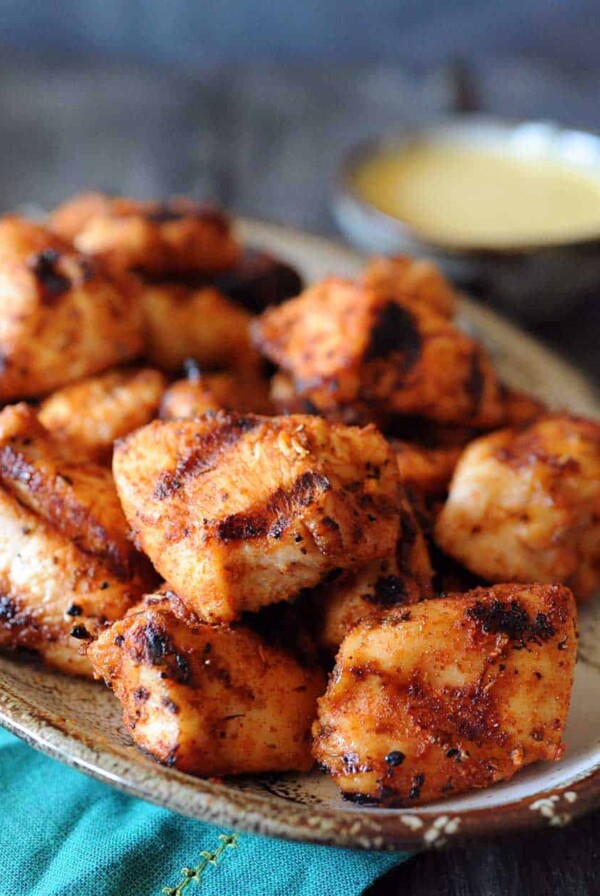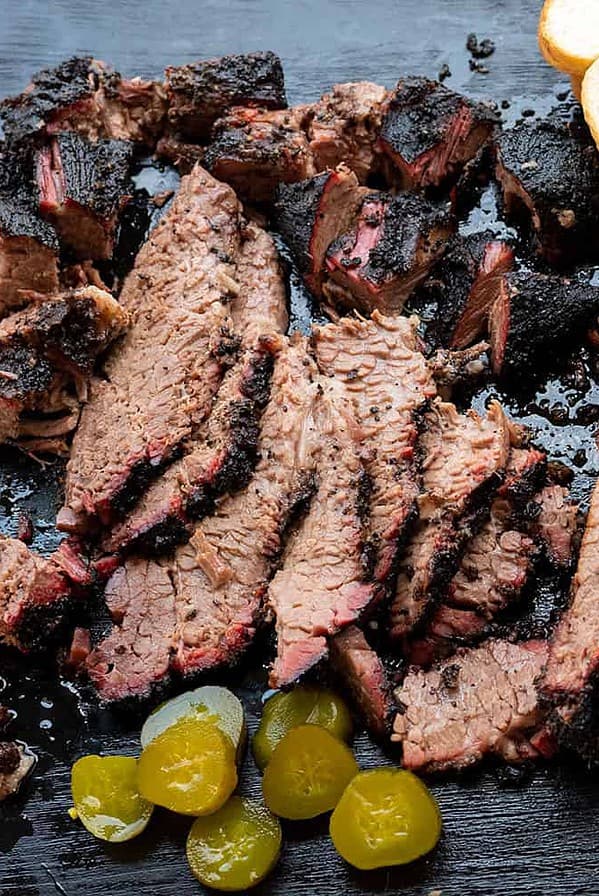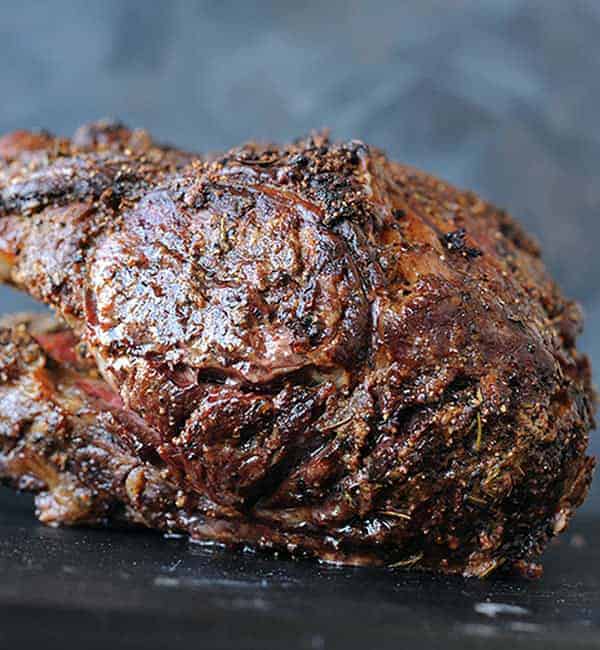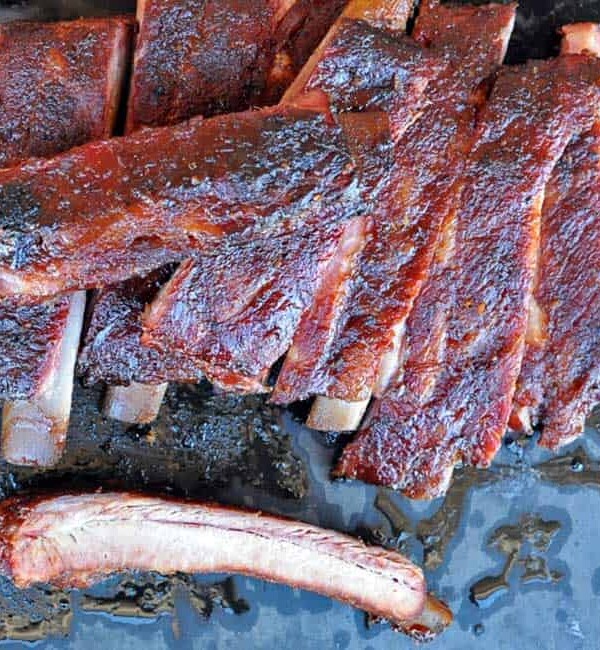Pitmaster Christie Vanover attended a BBQ competition, not to cook, but to judge. Find out what she learned and what changes she may now make.
This past weekend I traveled to California to participate in the Golden State Battle, which is a barbecue competition in California. But this time, I didn’t go to compete. I went to judge.
The night before the event, the California Barbecue Association actually held its annual awards ceremony. I want to take time to congratulate B’Mackin BBQ for earning team of the year and Cherry Anchor BBQ for earning Rookie of the Year.
They’re both tremendous teams. Big congrats to you guys.
Listen to the BBQ Tips Podcast on
Table of Contents
What is the KCBS?
The Golden State Battle is a barbecue competition that’s sanctioned by the Kansas City Barbecue Society.
For those who don’t know KCBS is a sanctioning body, that sanctions around 300 contests a year. The reason that it’s important when you’re competing to participate in a contest that’s sanctioned is because that ensures that there are general rules for the judges to follow, for the cooks to follow, and it just maintains accuracy and fairness so that it’s a pretty even level playing field.
I touched on my competition prep in a previous episode of the podcast, so be sure to go listen to that if you’re interested. But today I’m going to focus on what happens actually on site the day of the event.
So as a cook, we prepare our four meats, which are chicken, ribs, pork and brisket. We are required to place six pieces of each of those types of meat in a Styrofoam box that’s provided to us by the KCBS reps. We put our meat in that box and we bring it to the judges’ tent.
There are people sitting outside that take your box. Your number is on it. That was assigned to you by the rep. But they change that number and they assign it a different number.
It all gets switched so that it’s a double blind tasting.
Then inside the judges’ tent, there are tables set up so every single judge doesn’t taste every single entry. Instead, your entry goes to one table of six judges.
Those six judges are going to judge you on appearance, taste and tenderness.
The table captain
There’s also a table captain. That table captain is presenting the boxes to the judges. He or she is also collecting the scores after they’ve been judged, looking at them to make sure there’s not some oddity that somebody didn’t give a five.
If they gave a five, which is the lowest score, then they could question that judge if they felt that they needed to. So they just look for overall consistency.
Also, if somebody scored low, they may ask a judge if they could please give a comment card so they can explain why their score was so low. They evaluate that and then they take it to the reps who then do all the data entry.

Save this BBQ Tip
Enter your email, and I’ll send this link directly to your inbox. Plus, you’ll get new BBQ recipes and tips weekly.
Scoresheets and comment cards
So as a cook, we turn it all for meats and then we wait for awards. Then after the awards, each of the teams are invited to come forward and get their score sheets.
So when we get our score sheets, we’re able to see how we ranked amongst everybody who was competing. But we’re also able to see how we were judged.
We can see which table we landed on as far as table number, we have no idea which judges sat at which table, and I’ll see judge one, judge two, judge three, judge four just five, judge six, and what each of those judges gave me as a score for appearance, taste and tenderness.
If we don’t have comment cards, it’s really challenging to kind of guess or speculate why one judge might have given us a nine, which is a perfect score, and another judge maybe gave us a seven, which is an average score.
There’s no way for us to know what that judge was thinking or why they gave one score so high and one score like mediocre without that comment card.
There’s just lots of unknowns. And so as a cook, it can tend to be a little bit frustrating.
You just have to trust the system, but you never really know why your barbecue, if you think your barbecue was great that day, you never really know why your barbecue didn’t win or didn’t make top ten.
Why I judged this competition
So let me tell you why I decided to judge the Hollister competition. I have been getting top ten finishes all throughout 2023 and 2022 at the end of 2023 and starting into 2024, I started to actually be middle of the pack.
I wasn’t getting top ten calls anymore, but I felt like my meat was still equally as good as it has been for the past couple of years.
- I wanted to know what are the other teams turning in?
- Is that that drastically different from what I’m turning in?
- What kind of flavor profiles are successful teams using right now?
- Are my flavor profiles just dated?
- Are there new flavor profiles that the judges like?
- And overall, what’s appealing to judges?
I wanted to hear from judges, if I think something tastes great, but they don’t, so that I can kind of adjust my flavor profiles or appearance or tenderness or whatever it may be, if I needed to make adjustments. The best way for me to find out is to be inside that tent.
The KCBS JCUP Program
I became a certified judge in 2016. Actually, before I even competed, I wanted to know what the judges were looking for before I cooked up a bunch of meat and turned it in blindly.
Since then, the KCBS has introduced the JCUP program, which is the Judges Certification Update Program. I’ve completed that now as well too. The reason that you want to complete that is because the system for judging has changed a little bit.
So let me start by talking about the general rules for judging based on that KCBS JCUP program.

Overall, all of our boxes of meat are judged based on appearance, taste and tenderness. The scores now that judges can give range from a five to a nine, and right now with the JCUP program, they’re advising judges to kind of base it on an academic scale.
So nine is the highest score you can give. That should be an A or excellent. Five is the lowest score that you can give, which is poor or basically like a failing grade.
In addition to five through nine, a judge may also give a two, but that should only be reserved for something that’s inedible, like maybe some chicken that’s not fully cooked that you just can’t swallow.
A box can also receive a one, but that’s only if the box needs to be disqualified. That’s something that a judge will bring to the attention of the table captain. They actually have to get the rep involved before they can decide if it’s a DQ, but that’s the lowest score that a box can receive.
Basically, if you turn in a legal box as a cook, you’re going to get a score from a five through nine on appearance, taste and tenderness. And each of those scores are weighted a little bit differently with taste being the highest weight, followed by tenderness, and then appearance gets the lowest percentage of the weight of the score.
The judging process
When the boxes get turned in, they get added to these big trays and then the table captains carry those to the table of six judges.
Then the table captain opens the first box, shows it to judge number one, gives them a moment to judge the box on appearance and then continues to show the box to the remaining judges.
They close the box. They put it back on the tray. They grab the second box, again, show it to the first judge.
The judge scores that for appearance and they continue on. Here are some of the things that judges should be looking for. They need to ensure that there are at least six portions of meat within the box.
One thing that I learned through the JCUP program is it doesn’t mean you have to have six pieces of the same thing. For instance, with brisket, if you wanted to do three slices of flat and three burnt ends, that’s actually acceptable.

Also, during the appearance portion, that’s when judges are supposed to look to see if the garnish is legal. Garnish is completely optional, but it’s something that teams do to add a little bit of greenery so that their meat looks prettier in the box.
Judges cannot determine whether or not that garnish is pretty, whether it’s clean, whether it’s neat and tidy in the box. They can only determine if the garnish is legal.
What I mean by that is that you have to use a certain type of greens. The legal greens in 2024 are green lettuce, curly parsley, flat leaf parsley, curly green kale and cilantro.
Outside of that, if you have any other type of garnish in the box, they would be considered illegal.
There are a few other things that judges look for, for appearance. One, they want to make sure that the box is not marked in any way.
There should be no foreign objects in the box. That’s like no toothpicks or no foil. Also no pooling of sauce. That, too, is a DQ.
And lastly, you can have chunks in your sauce if you have onions or garlic or anything like that that’s in your sauce, especially if it’s homemade, that’s allowed. But it has to be smaller than one eighth of an inch cubed. If it’s larger than that, gain, the judge is supposed to report that to the table captain.
Judging for appearance
Here are some things that judges should not look for during the appearance phase.
They should not have any preconceived notions about what they want to be in the box or what they expect to be in the box. Just because they want burnt ends, if a box comes through and there are no burnt ends in the box, they cannot score down because they wanted burnt ends.
Next, the pieces in the box are not required to be symmetrical. When it comes to cooking chicken thighs, as a cook, we work really hard to get the perfect little pillow shapes as best as we can, but meat is natural.
There’s only so much we can do to manipulate the product.
And lastly, they cannot judge you down on appearance if you don’t have a smoke ring. Smoke rings can be artificially created. Therefore, they are not part of the judging parameters
All right. Now I’m going to go through each category appearance, taste and tenderness. Again, this is according to the KCBS’ JCUP. This is what the judges are specifically supposed to be looking for as the boxes get shown to the judges. It is a completely quiet process, both with your body language and with your voice.
If you see a box, you can’t be like, “That looks great,” because that might influence the judges next to you. Likewise, you can’t be like, “That’s not so good,” because again, you can’t have any influence.
It is a solo process of you as a judge judging that meat box. So be quiet. You write down your score, you hide your score, again, so nobody can even look at it and it doesn’t influence them. And then you wait for the next box to be shown.
If there are multiple cuts of meat in the box, let’s say it’s a pork box and you see some money muscles, some chunk meat and some pulled, your appearance score should be based on the totality of what’s in the box.
The money may look amazing. The shredded may look a little less desirable. So, again, base it on the totality of the box itself.
The cut types don’t matter. The fullness of the box doesn’t matter, nor does the placement.
Again, you’re not judging the layout, you’re not judging the fullness. You are strictly judging the appearance of the meat and how anticipated are you to eat it? Do you think it’s going to be an enjoyable experience?
You eat with your eyes first, so is this something that you want to dig into? If it’s something that looks really appealing that you can’t wait to taste, that’s a nine.
Judging for tenderness
After the table captain has shown everybody the boxes for appearance and all those scores are documented. Then he hands box number one to judge number one, and that judge then takes that one piece out and puts it on the placemat.
That judge passes it to judge number two and so on.
Then the table captain takes the second box and passes it to judge number one. Judge number one then takes a piece out of that box and places it on the placemat next to the first one.
The placemat itself has six squares, one for each piece of meat that’s presented, and each of those squares are numbered so that the judges know which score they’re giving for which meat.
Once the judges have all six pieces of meat on their placemat, then they can start to judge. They have to judge each entry one at a time.
So they will take a bite of the first piece of meat, judge it for tenderness and taste, document that score, set it down, clean their palate, move on to box number two, and do the same thing.
You can’t taste one and taste another and do comparative judging. Each meat stands on its own. You as a judge, are not trying to decide the winner of your table. You are judging each piece of meat independently.
They could all get nines. They could all get sevens. It doesn’t matter. Just how good is each piece of meat separately? That’s what you’re supposed to judge for.
Taste and tenderness can be judged at the same time because that’s when it comes down to taking the bite. But the JCUP actually recommends that the judges judge for tenderness first.
Take that bite, notice the tenderness, and then take a second bite if needed, and evaluate the taste and the flavor profiles. So let’s start with what the judges are supposed to look for when it comes to tenderness.
First, the judges are instructed to take a bite from the meatiest section of the meat and to bite perpendicular to the bone if there is a bone.
From there, you’re going to analyze the mouthfeel. Does it feel mushy? If so, it’s likely overcooked. Does it feel tight? Is it like hard to bite or hard to come free from the bone? If so, then it’s likely undercooked.
Overall, the judge is evaluating the ease of the bite, if it maintains the structure, if it’s nice and juicy.
Those are the things that determine the tenderness score.
Judging for taste
All right, let’s move on to taste.
What the judges are looking for is something that is overall appealing. They will smell it for aroma. They will taste it. You can have sauce and you can have rub, but the sauce and the rub should not overpower the meat itself.
It should complement it. Again, it’s a meat contest. So you want the meat to be flavorful and then the rubs and sauces to just complement that flavor.
You can choose to go salty, savory, sweet, umami, fruity. There’s so many options out there and it is all subjective. Every judge likes something a little bit different. So having something neutral as a cook is actually a little beneficial because then you’re more likely to please the palates of all the judges.
Those are the main guidelines and rules for the KCBS Judges Certification Update Program.
What happened when I judged
As KCBS certified judges. We’re told what happens in the judges’ tent, stays in the judge’s tent.
So I need to be mindful about what I share with you about my experience judging the Golden State Battle in California. I was completely enlightened, though.
What I can tell you from my judging experience was that the teams in California and on the West Coast are no joke. The meat and the boxes that they’re turning in are top notch.
It’s no wonder I’ve been middle of the pack lately because these teams are cooking their tails off. So I’ve definitely got some stiff competition.
Chicken
I think it’s safe for me, though, to share some of my general observations from my experience within the judges’ tent. Let’s start with chicken.
Overall, the appearance on the chicken was beautiful.
When it came to taste. The flavor profiles varied substantially. There was savory. There was sweet. There was spicy. There was salty.
This was when I had the opportunity to hear from the judges what they liked best. So as a judge, you write down your scores, you turn in your scores, and you have to wait for the rep to clear your table to say, “Okay, judging is done.”
Once judging is done, then as a judge, we can talk to the judges next to us and say, “What did you think of that one? Which one was your favorite?”
So that’s where I got that key knowledge. To hear the insider perspective of what the judges thought.
There was one piece of chicken, particularly that I thought was too salty. It tasted like it had a finishing rub with a little too much salt or maybe MSG. Another judge next to me thought the same thing, but another judge at the table absolutely loved it.
So either that piece that that judge got didn’t have as much of that seasoning on it or perhaps that judge just liked that flavor profile.
So again, it is subjective, but it tells me that you have to, as a cook, find a neutral flavor, something not too salty or not too spicy, but that’s a little bit more neutral so that you can please both of those palates.
The most appealing flavor profile for chicken tended to be on the savory sweet side for chicken. So something with a little bit of umami chickeny flavor with just that touch of sweetness.
When it came to tenderness, I would say that they were all pretty tender.
The ones that really popped out to the judges were the ones that were like bursting with juiciness where the meat was just glistening, was juicy all the way through.
One other thing with taste is you have to think about the taste of the meat. When it comes to chicken,
it’s not just what it tastes like when they taste that first bite from the outside where they’re getting the sauce and the rub. You also have to think about the meat inside.
So really important to flavor your meat and for your meat to be really juicy.
Ribs
Let’s move on to ribs. Rib placement and quantity in the box varied dramatically. But again, that doesn’t matter. We’re not judging on fullness of a box or the placement in the box.
What the judges do look for, though, is how does the meat look? Not just the top of the bones, not just the top of the ribs, but I noticed judges actually turning their heads side to side to make sure that they could see the sides of the ribs, to make sure that that meat looked appealing. And that’s something that they wanted to eat.
So think about that. As a cook, you need to make sure that the sides of your meat really look appetizing, not just the top of the box.
Tenderness on ribs is super tricky. You want that bite to come clean, but you don’t want it to be so tender that all of the meat falls off the bone. I will say at our table, the ribs tended to be a little bit on the tighter side versus the tender side.
That could also be due to whether it was really cold and rainy and windy at this competition.
But that’s what they’re looking for is that nice clean bite without it all coming off the bone. But the meat should also still be nice and juicy and tender.
From a taste perspective, it seemed like the judges really liked the fruitier flavor profiles, the peaches, the cherries. Those really seemed to be appealing to them, and those were the ones that stood out when they were pointing out which ones were their favorite.
One observation I made that stood out is it’s really important how you slice your ribs. So if you slice it too close to the bone on one side, you’re going to get a little bit of meat, whereas the other side of the bone might be a little bit thicker bite of meat.
The judge is supposed to bite the meatiest side of the bone and judge based on that, but they don’t always do that. You can’t control that. So if they bit the side that has the thinner amount of meat, you could get scored down in taste or even tenderness. So it’s really important to just cut your bones evenly.
I, as a judge, actually bite from both sides because I know what it’s like at noon when you’re slicing your ribs, trying to get them in the box and hustle as fast as you can because you’re still thinking about pork and brisket. That I may not have even slices either. But now I know that’s something I should focus on because you can’t control what side of the meat the judge bites
Pork
Moving on to pork. When you slice a piece of money muscle, your size of your money muscle can vary greatly.
Some people choose to use the larger chunk that kind of has that fat seam and it separates a little bit. And then some people choose to just use the smaller piece of money muscle without the fat seam.
Fortunately, I didn’t see that that made any impact on the judges when it came to appearance. They didn’t appear to be fazed by whether the money muscle was big or whether the money muscle was smaller. Fortunately, they’re just, again, judging on the appearance of what was in the box.
So I don’t think I’m swayed either way on whether I need to make sure I have really big money muscles or really small money muscles.
Also, some of the entries just had like six slices of money muscles, while others were really big, full boxes of muscles, chunks and pulled. And again, I didn’t notice that the judges judged poorly for anybody who didn’t have a full box, which is great because you’re not supposed to.
You’re just supposed to judge what’s in the box.
So I think there’s a lot of leniency there. Turn in your best meat. That’s the key takeaway I got from that category.
Also, when it came to taste those fruitier flavor profiles, again, the peaches and the cherries seem to really stand out. That seemed to be what the judges liked most.
When it came to tenderness, I will say most of the pork was on the side of maybe over tender, a little on the mushy side.
So judges are taught to take a bite and kind of push the pork against the roof of their mouth. And if it kind of dissolves and feels mushy, then you’re likely to get a lower tenderness score. But if it really holds its consistency while still being tender and not dry, then you’re going to get that higher score.
Brisket
The last category is brisket.
I will say that the brisket slices that were brushed with some sort of liquid or broth or jus or glaze were a little bit more appealing. They had a little shimmer to them and they just looked more appetizing. So I think those scored a little bit better on appearance.
When it came to tenderness for brisket, I will say the judges were pretty consistent.
Those briskets that were too tight definitely stand out more. And I think when a brisket is overcooked and is a little more tender, that’s where the subjectivity comes in.
One judge may prefer a brisket slice that’s really, really tender, while another may say, “Nope; it’s gone a little bit too far.” So there’s some variation in that just from judge to judge.
Then when it came to taste, I think what’s lacking in barbecue and I’ve noticed this when I’ve judged other competitions is a lot of us cooks are cooking hot and fast brisket.
Now, what that means is that we’re getting that smoke early on, but then we’re braising it in a liquid of broth or some other kind of mop, and then it’s going into kind of a boil stage.
So that takes away some of the smoke flavor. And in a lot of pieces, I wasn’t tasting that much umami, beefiness, saltiness. It just kind of lost that because of the liquid that we’re cooking things in.
The briskets that stood out to me are those that had that pop of smoke. that pop of a umami, that pop of saltiness.
Again, my takeaways from judging this past weekend are that the West Coast teams are really good.
My final thoughts after judging
After judging, then I got back to my hotel room, and I thought about my cooks and what I’m turning in and how would those compare if one of my pieces of meat landed on one of the judges tables? How would it compare?
Even though judges aren’t supposed to compare meat to meat, to meat and team to team to team, I still know in my mind as a judge, does mine taste tender, does mine taste juicy?
And while I’m in the heat of it in my trailer, I think it tastes amazing, now that I reflect back, I know there’s some changes I can make.
Well, that’s a wrap for this week. I hope this has been really helpful for you guys. If you are a cook and you haven’t judged yet, I highly do recommend that you take the KCBS CBJ class so you can learn more about this yourself.
And I also highly recommend that you sign up to judge a competition. Judges who want to become master judges are actually required to cook a competition, which I think is great.
But I think cooks should also judge every now and then. So that’s what I’m going to be doing, kind of balancing my judging in my cooking. I think my next cook is going to be in Perris, California, in April, so we’ll see how that goes.
Now I can take all this information that I learned, practice a little bit and get ready for the cook.
If this week’s BBQ Tips Podcast was helpful for you guys, I would love it if you would leave a rating or be sure to subscribe so you never miss a future tip.
Tune into more of my BBQ Tips podcasts or scroll around the website for even more helpful BBQ Tips.












